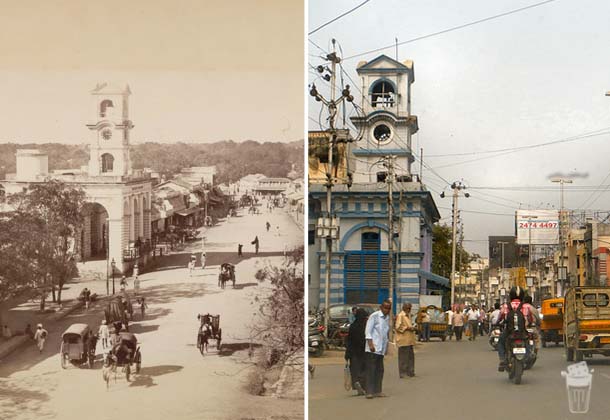The city of Secunderabad was formed in 1806, after the order was signed by the Nizam allotting the land north of Hussain Sagar to set up the British Cantonment. The twin cities are separated by the man-made Hussain Sagar lake, which was built during the reign of the Qutb Shahi dynasty in the 16th century.
Two hundred years has changed Secunderabad. From Sikandrabad, named after Mir Akbar Ali Khan Sikander Jah (1803-1829), the third Nizam of Asaf Jahi dynasty, it assumed the anglicised name of Secunderabad, the preserve of the Army in the British Raj.
The landscape has changed, people’s attitudes have changed, names of streets have changed (barring a few) and the environment has gotten
worse.
Pollution free Tongas and cycle rickshaws have been replaced by petrol/diesel driven vehicles.
May flower trees are gone so are the chirping birds.
A concrete jungle of haphazard constructions, multi-storied buildings, and polluted streets replaced the once peaceful, green covered British Cantonment.
Founded in the late 18th century as a British cantonment through a pact between the Nizam of Hyderabad and the East India Company, this exclusive cantonment area was named Sikandrabad.
In 1803, Nizam Sikandar Jah, the third Nizam of Hyderabad, changed Ulwul’s name to Secunderabad after himself.
Unlike its immediate neighbour and twin, Hyderabad, Secunderabad had a distinct culture.
It was more cosmopolitan, followed the stringent British regime, and senior citizens insist the place once resembled a British County.
In true Indian colour, it was dotted by temples, churches, mosques and Parsi fire temples, and nurtured saplings of all the communities, who lived in perfect harmony, barring a few stormy years during the Razakaar movement.
Sikandrabad took pride in having its own “Little London,” now Lallaguda, a home to the Anglo-Indian community even today.
Over the years, the landmarks too have changed. Dreamland, the once popular venue for English movies now houses a marriage hall.
Plaza, another popular theatre with a bar attached has been turned into a commercial complex. A big part of Tivoli theatre has now been turned into a function hall!
“These theatres very popular then. There was utmost discipline, and whistling or screaming for the lead actors was taboo,” recalls 83-year-old Mr D.N. Gupta, a resident of Marredpally.
Discipline was a unique characteristic of the city.
Says 77-year-old Mr Mekala Srisailam, a grain merchant and resident of Old Ghasmandi,“The British imposed discipline to the hilt.
People were fined for
urinating at public places, washing of clothes and utensils at public taps and littering the roads. People used to run away on seeing a Dafedar (sanitary inspector). And double sawari (double seat on a bicycle) was
banned.”
Popular landmarks and street names are lost forever.
- The Famed King Edward Memorial (KEM), renamed Gandhi Hospital has been shifted to Musheerabad Jail, Kingsway (RP Road), Alexander Road (SP Road), Oxford Street (SD Road) and the Victoria Grain Market (now a slum) are part of a bygone era.
- Aladdin Building in Begumpet has gone into oblivion and the street now showcases multi-storied malls.
- The old Percy’s Hotel, Modern Café and Radio Hotel have been replaced by Garden Hotel, Taj Mahal, Anand Bhavan, Nanking, Basera and the Kamats.
- DBR Mills and age old Praga Tools is now defunct.
But some landmarks have withstood the test of time. Secunderabad Club,
St Ann’s School, Mahabub College, Wesley School, Paropakarini Balika
High School, Zoroastrian Club, Clock Tower, Raja Deendayal studio, Chimulgi Studio, YWCA, British Residency, Trimulghery fort, the Trinity Church, Cantonment Garden, Hyderabad Public School (Jagirdar College) to name a few.
General Bazar was unique. You get everything here. From Railway Line Boxes, steel boxes, drums manufactured by Ashok Trunk Factory owned by C V Ramalingam to paints shop of Ganji Brothers, oil, paper, essence, acid, Anam, Pilli, Nagam Krishna etc family gold jewellary, clothes, general stores, essence, aerated drinks, decorative items, stationery, to vegetables. Even today its a shoppers paradise for all class of people.
Little further away is Monday Market, grain bazar, famed for food stuffs.
Says P. Anuradha Reddy, environmental activist and a resident of Walker Town now Padma Rao Nagar). “Secunderabad was safe, clean and had a beautiful environment.”
Dr Shirley Elias, 65, a resident of AWHO Colony sums up the change: “During those days Mayflower trees lined the roadsides and a stroll in
the mornings and evenings was a pleasant experience. Now, the place is too crowded and polluted.
City houses famed Raja Deendayal, Emmanuel, Pavan Studio and other photo studios.
Story written on the occasion of 200 years of Secunderabad couple of years ago.
Hyderabad and Secunderabad form one of the few twin cities of the world. Secunderabad is located on the northern side of the Hyderabad urban agglomeration.
The cities have merged through an imaginary line drawn across the Tank Bund, which is still used to demarcate the cities.
The Secunderabad Cantonment comprises a number of defense establishments.
In 1798 through an alliance signed between Hyderabad’s Nizam Sikander Jah and the British East India Company, an area north of Hussain Sagar Lake was made into a cantonment named Secunderabad after Nizam Sikander Jah.
Presently, Secunderabad Cantonment area falls under the Secunderabad Cantonment Board, which is a local body falling under the administrative control of Ministry of Defence, Government of India.
Primarily, the Secunderabad Cantonment Board is responsible for carrying out the civic amenities to the residents of the Cantonment area.
The area of Secunderabad Cantonment is about 40.17 sq. km and the civil population is 2,06,102 as per the 2001 census.
Historically, cantonments were places where the army of colonial government had to be exclusively quartered in an effort to keep the armed forces totally insulated from the ruled.
Cantonments meant quarters assigned for lodging troops, a permanent military station created by the British government in India for the location of military formation away from the civilian towns and insulated from the Indian nationalist influences. Housing was the core objective.
Subsequently, housing itself attracted the civil population to reside in the cantonments and the economic spin-offs attracted other activities.
The bazaar area was recognized and the anatomy of the cantonment got clearly defined with military, the bungalow and civil areas clearly defined. The cantonments as local self-government organizations have always remained a puzzle.
The civilian population wants to be in it but is uncertain about their status and their future.
Due to repeated demand for reforms by the representatives of cantonment population, the Cantonments Act, 1924 was enacted to introduce local self-government in the cantonments, which contained substantial civil population.
The Act was the first model municipal Act for cantonments, but in its implementation, decentralization and democratic norms were largely compromised because of the status of the citizen who occupied the property only as a licensee of the Government.
In 2006 the Cantonments Act, 1924 was replaced by the Cantonment Act, 2006 with a view to impart greater democratization and improve the financial base of cantonments to make provision for developmental activities.
Presently there are 62 Cantonments in the country distributed among five Army Commands.
The cantonments are categorized as Category I, Category II, Category III and Category IV on the basis of the civil population. As per the latest Census, Secunderabad cantonment area falls under Category I, with a population above 50,000.
In the current urbanizing scenario, Hyderabad Urban Agglomeration (HUA) is the sixth largest in India, with a population of 5.75 million in the year 2001. Compared to the MCH, the level of services and infrastructure in Secunderabad Cantonment has been poor.
In addition to this, the lack of a comprehensive development plan/ master plan for the cantonment has further exacerbated the situation.
The City Development Plan prepared for Hyderabad under JNNURM does not include the Secunderabad Cantonment Area. The Cantonment Act 1924 revised in 2006 has provision for preparation and Implementation of Town Planning Scheme, but the Act does not have any provision for preparing a Comprehensive Development Plan.
It is in this context that the Secunderabad Cantonment Board (SCB) was requested to prepare a cantonment development plan to forecast the requirements of basic infrastructure facilities, and submit it to central government for funding under JnNURM. #HydTravel #hydnews

